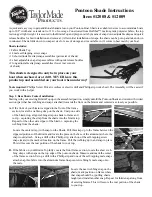
Safety
19
Make absolutely sure that you can react to an alarm within a few
seconds. Move away from patients only so far that you can reach
them within ten seconds.
Never modify settings without consulting
the responsible doctor.
Only the doctor knows the correct alarm limits and monitor configu-
ration for each patient.
When you are not sure that VitaGuard® is in perfect operating order,
check the patient’s vital functions. Under no circumstances should
you use VitaGuard® when you suspect a device defect.
In the event of ANY suspected VitaGuard® malfunction, continue to
observe the patient until you can use a replacement monitor, or
VitaGuard® has been examined by the doctor or authorized dealer.
Stop using VitaGuard® after the servicing interval of eighteen
months has expired. Before the end of this period, make an ap-
pointment with your authorized dealer to check the safety and
operability of your device.
Test the acoustic alarm unit every time you switch on VitaGuard®.
This is explained in the section “Alarm test” on page 56.
Treat all leads and connections with particular care, and never use
the connecting cables to lift VitaGuard®.
Switch off VitaGuard® before boarding an aircraft. When you want
to transport VitaGuard® in your luggage, you should remove the
batteries. This prevents other pieces of luggage from switching on
the device by accident. An activated, but disconnected VitaGuard®
will generate acoustic alarm signals.
3.2
Allergy risks to patients
Attach SpO
2
sensors to intact areas of skin only.
The use of SpO
2
sensors with adhesive materials may cause problems
when the patient develops an allergy to adhesive tape or similar.
Summary of Contents for VitaGuard VG310
Page 1: ...VitaGuard VG310 Pulse oximeter Operating instructions...
Page 2: ......
Page 4: ......
Page 10: ...Table of contents...
Page 108: ...108 Evaluating stored data on a PC Fig 79 VitaWin register Events in graph form...
















































